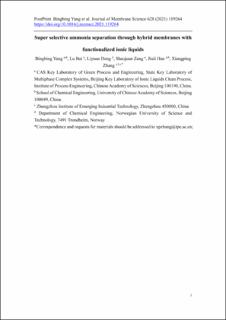Super selective ammonia separation through multiple-site interaction with ionic liquid-based hybrid membranes
Yang, Bingbing; Bai, Lu; Li, Tingting; Deng, Liyuan; Liu, Lei; Zeng, Shaojuan; Han, Jiuli; Zhang, Xiangping
Peer reviewed, Journal article
Accepted version
Permanent lenke
https://hdl.handle.net/11250/3119242Utgivelsesdato
2021Metadata
Vis full innførselSamlinger
Sammendrag
Efficient separation and recovery of ammonia (NH3) is essential for environmental protection and resource utilization. In this work, hybrid membranes for NH3 separation through multiple-site interaction were developed by combining the unique features of ionic liquids (ILs) and a midblock-sulfonated block copolymer. The functionalized ILs ([2-Mim][NTf2] and [Im][NTf2]) with ammonia interaction sites were incorporated into the Nexar™ matrix, which greatly improves the affinity for NH3 over nitrogen (N2) and hydrogen (H2). Benefited from the self-assembly of the block copolymer, the hybrid membranes primarily exhibit lamellar morphology. More continuous ionic domains with well-distributed ILs were formed in the hybrid membranes, contributing to forming interconnected channels for enhanced gas transport. In this case, addition of the ILs into the Nexar matrix significantly enhances NH3 separation performance. Nexar/[Im][NTf2]-25 membrane achieves the highest NH3 permeability of 3565 Barrer and a maximum NH3/N2 and NH3/H2 ideal selectivity of 1865 and 364, respectively. The significantly enhanced NH3 permeation compared with the neat Nexar membrane indicates the positive role of ILs in the hybrid membranes.
